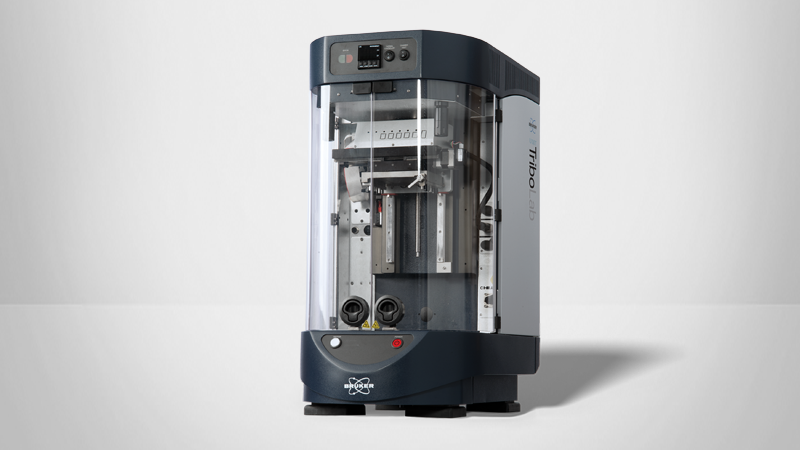In reciprocating test generated in the Stribeck curve
Stribeck curve is used to describe the liquid lubricant in boundary lubrication, the mixed lubrication and friction characteristics of hydrodynamic lubrication condition.Each state by the ratio of film thickness and surface roughness or lambda than definition (figure 1).These curves are usually used to evaluate lubricant viscosity, lubricant additives, changes, or the influence of surface roughness.Generate the main premise of the Stribeck curve is a fluid friction pair are inhaled contact clearance, resulting in a support load of stress increment (figure 2).
History/structure of traditional test
Thurston1Martens,2The Stribeck3And Hersey4Classical works are done using the radial sliding bearing structural geometry, the method satisfies the requirement of all of the above (figure 3).Using instruments for radial sliding bearing test can evaluate relative velocity and/or load only within a certain range of friction.In the Stribeck curve, draw the coefficient of friction (COF package) control of key parameters are called Hersey.Hersey's speed (m/s) multiplied by the dynamic viscosity (Pa, s = N, s/m2) divided by the bearing load per unit length (N/m) of the proceeds of the dimensionless number.
Get the Stribeck curve is the simplest and most commonly used method, on the premise of proper convergence gap models available, to fix two variables (such as load and viscosity), and changes in the appropriate range and the third variables (e.g., velocity), so that the contact interface through the asperity contact area (boundary lubrication) and completely liquid membrane separation (hydrodynamic lubrication) area.In the laboratory, the simplest method is under submerged lubrication, use pin rotate (POD) in the face of a unidirectional friction test, and according to the contact pin end face shape gap model.
The reciprocating movement of the Stribeck curve
However, the recent use of reciprocating friction test mode to evaluate lubricant properties has attracted interest.This kind of test equipment are sometimes referred to as the high frequency reciprocating apparatus (HFRR) or the SRV tests.(SRV is German Schwingung Reibung Verschlei decide, means reciprocating friction and wear).Using a sample of the reciprocating test model is simulated in automobile engine cylinder lubrication of piston ring.
In reciprocating mode to generate the challenge for the Stribeck curve inversion before on a sufficiently long stroke length to produce enough speed, in order to meet the hydrodynamic lubrication state the required pressure and film thickness.This description describes under the condition of high frequency reciprocating motion, using polishing cylindrical pin side against the highly polished slab model tests.To this end, the testing samples in equipped with heating high-speed reciprocating brooke UMT TriboLab (figure 4).
In this type of high frequency reciprocating module (HFRR), 30 Hz under the condition of the average speed of 0.42 m/SEC, on the stroke when maximum speed up to 0.59 m/SEC, sufficient hydrodynamic lubrication state.Standard cylindrical steel pin (diameter of 9.5 mm x 15.5 mm in length, roughness (including 19 m Ra) fixed in aligned can rotate the bracket, and pressure in a highly polished steel 52100 (including 0.013 m Ra).Figure 5 a shows the sample in the testing room, you can also use the samples made of the actual parts instead of cylindrical pin and tablet (FIG. 5 b).
All tests in the stroke length is fixed for 7 mm, load fixed to 20 N, frequency of 0.1 Hz to 30 Hz.Using three different viscosity of oil poly alpha olefin (PAOs), namely, PAO 2, 10 and PAO PAO - - 40 (dash number refers to the viscosity of 100 ℃ to cSt).Test at room temperature.Figure 6 shows the three lubricant viscosity test of the Stribeck curve.
Other standard reciprocating test function
Now both reciprocating motion and one-way movement, no published generated Stribeck curve of standard test methods, but for the bottom of the sample, can use the reciprocating movement of the same for many other lubricant performance related tests.Through the above will be replaced with spherical or cylindrical pin sample flat pin, and adjust the frequency and/or stroke length, you can use the same Settings, run the following ASTM, DIN or ISO standard issued by reciprocating test:
ASTM D5706-11:Using a high frequency linear oscillation (SRV) tester standard test method for determination of extreme pressure grease properties
ASTM D5707-11:Grease friction and wear performance measurement method (high-frequency linear vibration tester) standard test method
ASTM D6425:Measurement of extreme pressure (EP) lubricant friction and wear properties of standard test method
ASTM D6079-11:Using high frequency reciprocating tester (HFRR) assessment of diesel fuel lubricity of standard test method
ASTM D7688-11:Through visual inspection using high frequency reciprocating tester (HFRR) assessment of diesel fuel lubricity of standard test method
ASTM D7594-11:Using a high frequency linear oscillation (SRV) tester determination of grease under high hertzian contact pressure the friction and wear resistance of standard test methods
ASTM D7755-11:High frequency linear oscillation (SRV) testing machine with standard sample wear amount of standard operating procedures
ASTM G133-10:Linear reciprocating ball plane sliding wear standard test methods
ASTM G203-10:Determination of reciprocation friction friction in the system to the dissipation of standard guidelines
ASTM G206-11:Measuring piston ring collision in reciprocating wear test flat sample wear standard guidelines
DIN 51834:The friction and wear value determination of lubricating oil
ISO 12156-1:6:Diesel - using high frequency reciprocating device (HFRR) for evaluation of lubricating oil. Part 1: test methods
The author
Dr Steve Shaffer
Brooke advanced application scientist
The resources
- Thurston, Robert h., using new methods and new instruments measure law of friction and coefficient of friction, Trubner and Co, London, 1879.
- Martens, Adolf, Schmieroluntersuchungen [oil], Mitteilungen aus den Koniglichen Technischen Versuchsanstalten zu Berlin, Erganzungsheft III [Berlin the royal institute of technology test release, supplementary volume III], Julius Springer, Berlin, 1888, 1-37.
- The Stribeck, Richard, Die Wesentlichen Eigenschaften der Gleit - und Rollenlager [] is the main feature of sliding bearing and rolling bearing, Zeitschrift des Vereins sell Ingenieure [German engineers association magazine] 36 (46), 1-48143-38, 1902134 and 1463-70.
- Hersey, Mayo, horizontal radial bearing lubrication regularity, journal of Washington academy of sciences, 4191, 4.
- Society of Tribologists and Lubrication Engineers - www.stle.org
